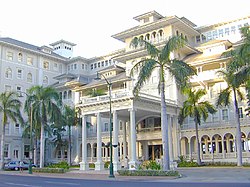Moana Hotel
|
Moana Hotel
|
|

The Moana Hotel opened in 1901.
|
|
| Location | Honolulu, HI |
|---|---|
| Coordinates | 21°16′35.41″N 157°49′35.9″W / 21.2765028°N 157.826639°WCoordinates: 21°16′35.41″N 157°49′35.9″W / 21.2765028°N 157.826639°W |
| Built | 1901 |
| Architect | Oliver G. Traphagen |
| Architectural style | Hawaiian Gothic |
| Website | http://www.moana-surfrider.com/ |
| NRHP Reference # | 72000417 |
| Added to NRHP | August 7, 1972 |
The Moana Hotel is a historic hotel on the island of Oahu, at 2365 Kalākaua Avenue in Honolulu, Hawaii. Built in the late 19th century as the first hotel in Waikiki, the Moana opened in 1901. It is listed on the National Register of Historic Places.
The wealthy Honolulu landowner Walter Chamberlain Peacock, in an effort to establish a fine resort in the previously neglected Waikiki area of Honolulu, incorporated the Moana Hotel Company in 1896. Working with a design by architect Oliver G. Traphagen and $150,000 in capital, The Lucas Brothers contractors completed the structure in 1901. Construction of The Moana marked the beginning of tourism in Waikiki, becoming the first hotel amidst the bungalows and beach houses.
The Moana's architecture was influenced by European styles popular at the time, with Ionic columns and intricate woodwork and plaster detailing throughout the building. The Moana was designed with a grand porte cochere on the street side and wide lānais on the ocean side. Some of the 75 guest rooms had telephones and bathrooms (unusual at the time), and the hotel featured a billiard room, saloon, main parlor, reception area, and library. Peacock installed the first electric-powered elevator in the islands at the Moana, which is still in use today.
Design features of the original structure that survive to this day include extra-wide hallways (to accommodate steamer trunks), high ceilings, and cross-ventilation windows (to cool the rooms prior to air conditioning).
The Moana officially opened on March 11, 1901. Its first guests were a group of Shriners, who paid $1.50 per night for their rooms. Peacock did not find success with his endeavor and sold the hotel in 1907 to Alexander Young, a prominent businessman with other hotel holdings. After Young died in 1910, his Territorial Hotel Company operated the hotel until they went bankrupt in the Great Depression, and the Matson Navigation Company bought the property in 1932 for $1.6 million.
...
Wikipedia
